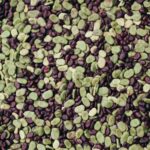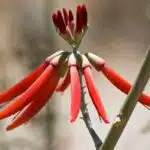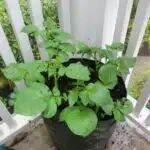Gardening gives great gratification to those with green thumbs. Growing yardlong beans is a task that can be especially satisfying, as the rewards of your labor will be evident in the round pods that hang off the vines. These exotic vegetables are packed with flavor and nutrition, making them a great addition to any garden. With some patience and know-how, anyone can cultivate these delectable Asian-style beans in their own backyards.
Pleasingly plump pod plants, yardlong beans are known by many names: Chinese long beans, snake beans, and asparagus beans. Their unique shape and size make them an attractive addition to any vegetable patch. While they may look intimidating to grow at first glance, yardlong beans are actually quite easy to cultivate with minimal effort. With proper soil preparation and planting techniques, you can harvest your own bounty of these delicious legumes in no time!
Experienced gardeners know that understanding a plant’s needs is key for growing success. Thankfully, yardlong beans are incredibly resilient and hardy – but there are still some important tips and tricks for achieving optimal growth conditions for this particular vegetable crop. If you’re ready to get started on your own yardlong bean adventure, read on for all the information you need to know about planting and caring for these tasty vining vegetables!
Choosing A Variety Of Yardlong Beans
When it comes to growing yardlong beans, variety selection is essential. Different varieties have varying characteristics, such as the size of the bean pod and the length of time they take to mature. It’s important to pick a variety that suits your preferences and climate. Generally speaking, there are two categories of yardlong beans – bush and climbing types. Bush types tend to be shorter in height and produce an abundance of long, slender pods. On the other hand, climbing varieties require some type of support structure such as a trellis or fence and will typically produce fewer but longer pods.
Once you’ve chosen a variety, you’ll need to consider the soil requirements for successful growth. Yardlong beans prefer well-drained soils that are slightly acidic with a pH between 6.0 and 6.5; however, they can tolerate more neutral soils if need be. In addition, they will benefit from plenty of organic matter such as compost or manure being added to their environment prior to planting. Moreover, it’s also beneficial to provide them with consistent watering throughout their growing season; however, be sure not to overwater as this can lead to root rot or other fungal diseases which could damage your crop.
In order for yardlong beans to thrive in your garden environment, it’s imperative that you take into account all factors including soil type, water requirements and fertilizer needs before planting them in your garden beds. By doing so you’ll ensure a healthy and abundant yield come harvest time! With these considerations taken care of we can now move onto examining the soil requirements for successful growth of yardlong beans…
Soil Requirements For Yardlong Beans
Growing yardlong beans requires one to consider the soil requirements. These legumes are sensitive to soil conditions and need certain elements in order to thrive. Generally speaking, yardlong beans will grow best in a loamy soil with good drainage. It’s important that the pH of the soil be slightly acidic, around 6.0 or 6.5. The soil should also contain plenty of organic matter, such as composted manure or aged leaves, which helps provide nutrients for optimal growth and production.
In addition to these key elements, it’s essential that you add extra calcium to the soil when planting yardlong beans; this is especially true in areas where the soils are naturally low in calcium. Calcium helps to prevent blossom end rot and other nutrient-related issues during the growing season. Adding lime or gypsum can help raise calcium levels in the soil, but make sure to test your soil before adding either of these materials so that you don’t overdo it.
By taking these steps before planting, you’ll give your yardlong beans a great start and ensure they have all the nutrients they need for vigorous growth throughout the season.
Planting Yardlong Beans
Planting yardlong beans can be a rewarding experience for the gardener. The key to success is to choose the right variety and plant it in appropriate conditions. Here are three steps to help you get started:
Select a variety of yardlong bean that suits your climate. Yardlong beans are classified as either bush or pole type varieties, so select one based on available space and desired yield.
Prepare the soil. Yardlong beans prefer well-draining, nutrient-rich soil with a pH of 6.0 to 7.0 and plenty of organic matter such as compost or aged manure incorporated into the soil prior to planting.
Plant seeds at least 1 inch deep and 3 inches apart in rows spaced about 24 inches apart for bush types and 36 inches for pole types. Water immediately after planting, then continue watering regularly during dry spells throughout the growing season to ensure healthy growth and maximum yield from your crop.
Careful attention during planting will ensure that your yardlong beans have everything they need to thrive. Allow the top few inches of soil to dry out between waterings, as too much moisture can lead to root rot and other problems that limit yields. With proper care, you may soon be harvesting an abundant crop of delicious yardlong beans!
Watering Yardlong Beans
Watering yardlong beans is like pouring a refreshing glass of water on a thirsty plant. It is an essential step in their growth and should be done with care. Botanists and gardeners must be aware of the needs of these plants to help them thrive.
When watering yardlong beans, it’s important to remember that they do not like to have wet feet. This means that if you water the soil too much, the roots may become waterlogged and cause the plant to rot or weaken. The best approach is to give them deep, infrequent watering sessions instead. Water until the top 6 inches of soil are moistened, but don’t let it get muddy or soggy. This will help encourage deeper root development for better nutrient absorption and drought resistance in the future.
It’s also important to pay attention to the weather conditions in your area when watering yardlong beans. If there is rain expected within 24 hours, you can skip a day or two in between waterings as nature will provide a good amount of moisture on its own. In extremely hot temperatures or extended dry spells, however, it’s recommended that you water more often so that your plants don’t suffer from dehydration or wilting leaves due to lack of hydration. With proper care and attention your yardlong beans can grow healthy and strong!
Fertilizing Yardlong Beans
Fertilizing yardlong beans is an important part of their care and growth. When it comes to fertilizing, long beans have different needs than other types of beans. Chinese long beans need a balanced fertilizer with an equal ratio of nitrogen, phosphorous, and potassium available. Furthermore, they require higher levels of potassium during the flowering stage, as well as additional iron once the pods start to form.
It’s best to apply the fertilizer around the base of each plant at least twice per growing season. The ideal time for application is when they are actively growing in the spring and again in midsummer. If possible, use an organic water-soluble fertilizer so that you can monitor how much nutrient your plants are receiving throughout their growth cycle. Avoid over-fertilizing; too much fertilizer can damage or even kill your plants.
In order to get the most out of your fertilization efforts, be sure to regularly water your plants before applying any type of fertilizer. This will allow for proper absorption of nutrients into the soil and ensure that your long beans receive all of their necessary nutrients for optimal growth and production. With proper fertilization and regular watering, you can expect a healthy crop of delicious yardlong beans!
Trellising Yardlong Beans
A trellis is an important tool for growing yardlong beans and other climbing plants. Allowing the beans to grow up, instead of sprawling around on the ground, increases the amount of sunlight they receive and can even double or triple your harvest. But before you set up a trellis, there are a few things you should know.
As a specialist in botany and gardening, I have seen first-hand how beneficial it can be to trellis yardlong beans. Not only do they grow faster, but they also produce more beans per plant. Taking just a few extra steps to build a trellis can make all the difference. The most common types of trellises for yardlong beans are made from bamboo or wire mesh and should be about 8 feet tall so that the vines have plenty of room to climb.
When installing your trellis, be sure it’s securely anchored into the ground with stakes or posts. Then, use twine or thin rope to tie your bean vines to the trellis as they grow taller. This will help keep them upright and make harvesting easier when the time comes. With proper care and attention, you’ll soon be enjoying your own homegrown yardlong beans!
By providing support for your yardlong bean plants with a trellis, you’ll reap the rewards with an abundant crop each year. Now that you’ve mastered this step in growing these delicious green pods, it’s time to move on to controlling weeds in your beds which is equally important for a successful harvest.
Controlling Weeds In Yardlong Bean Beds
The bean is a powerful symbol of growth and resilience, capable of flourishing in even the harshest conditions. But for yardlong beans to reach their full potential, they need more than just persistence—they need the right environment. This means controlling weeds in their beds, so that the plants can focus their energy on producing lush green vines and abundant pods.
Weed control is essential for healthy yardlong bean crops. Gardeners must take steps to reduce weed germination and prevent existing weeds from growing. To do this, they should pull out weeds when they are small and easily identifiable, or smother them with mulch or another organic material to deprive them of light and oxygen. They may also choose to use chemical herbicides if other methods have failed.
When using herbicides, it’s important to find one that’s labeled safe for edible plants like beans, follow all safety precautions on the product label, apply it according to directions, and monitor the area regularly for any signs of damage or health issues with the bean plants. Additionally, gardeners should be aware of any local regulations regarding pesticide use and make sure to adhere to those guidelines as well.
By taking these steps and creating an environment free from weeds, gardeners can ensure that yardlong beans get all the nutrients and sunlight they need to thrive. With a little care from us humans (and lots of help from Mother Nature), we can help these amazing legumes reach their full potential!
Controlling Pests In Yardlong Bean Beds
Controlling pests in yardlong bean beds is a critical part of growing the beans. Insects, rodents, and other animals can wreak havoc on a garden’s yield. Fortunately, there are several steps you can take to prevent pest damage.
First, keep your garden clean and free of debris. Removing dead plants and weeds will reduce the number of places where pests can hide. Additionally, be sure to rotate your crops annually; this will help prevent infestations from developing.
Next, use organic pesticides if necessary. Neem oil is a popular choice for controlling aphids and other common pests in vegetable gardens. Be sure to apply these products according to the instructions on the label so as not to harm beneficial insects like bees or ladybugs. Finally, consider using companion planting techniques such as interplanting with onions or garlic to deter certain pests from invading your garden beds. TIP: To make controlling pests easier, try planting insect-repelling flowers near your yardlong bean beds for an extra layer of protection against unwanted visitors!
Harvesting Yardlong Beans
Harvesting yardlong beans is a rewarding experience for many gardeners. Imagine plucking these vibrant green beans from their vines, ready to cook and devour. To get the most out of this experience, there are a few things that need to be taken into consideration:
- Identify when the beans are ready to harvest;
- Plan how you will store them; and
- Make sure you gather the beans regularly once they’ve reached maturity.
For gardeners looking to harvest yardlong beans, timing is key. The pods should be picked when they reach their full length and have a bright green colour; this usually takes approximately two months after planting. Once harvested, the beans should be used as soon as possible, as they don’t store well – especially if they are left on the vine too long, which will cause them to become tough and inedible. It’s important for gardeners to keep an eye on their bean plants every few days in order to make sure that no pods get missed or over-mature.
The best way to store harvested yardlong beans is by blanching them quickly and then freezing them in plastic bags or containers for future usage. This ensures that the freshness of the bean remains intact while keeping it safe from spoiling or pests. Additionally, dehydrated yardlong beans can also be stored in airtight containers at room temperature for up to one year – perfect for those who want to enjoy fresh-tasting yardlong beans all year round! As we move onto storing our precious bounty of yardlong beans…
Storing Yardlong Beans
As the harvesting of yardlong beans comes to a close, the next step of this process is storing them. Storing your freshly harvested yardlong beans is an essential part of the gardening experience, as proper storage can maximize their flavor and longevity.
As a botanist who specializes in gardening, I have seen many different methods for storing yardlong beans successfully. For example, one way to store them is to place them in a paper bag, punch holes in it for air circulation, and then hang it in a cool location with low humidity such as a garage or basement. Another method I have seen used with excellent results involves washing the fresh yardlong beans then drying them thoroughly before wrapping them tightly in plastic wrap and placing them in the refrigerator.
No matter which method you choose for storing your freshly harvested yardlong beans, it’s important that they are kept out of direct sunlight and at temperatures below 70 degrees Fahrenheit. Doing so will ensure that they stay fresh and full of flavor even after months of storage. With these tips in mind, you can confidently enjoy delicious yardlong beans all year round!
Cooking Yardlong Beans
Cooking yardlong beans is a straightforward process that can yield delicious results. With their long shape and tender texture, these beans are ideal for stir-fries and other quick cooking dishes. Here are some tips for getting the most out of your yardlong bean harvest:
• Pre-soak your beans for at least an hour before cooking to reduce their cooking time. • Slice them into 1” pieces to ensure even cooking throughout. • Cook in a wok or large skillet over medium high heat with some oil, stirring constantly until they turn bright green. • Add spices and sauces during the last few minutes of cooking to give them flavor. • Serve as soon as possible after cooking for the best taste and texture.
For those looking to maximize their culinary experience with yardlong beans, there are numerous ways to enjoy them! Try adding them to soup, roasting them with olive oil, or braising them in a flavorful sauce. No matter how you choose to cook yardlong beans, they will add color and flavor to any dish. As an added bonus, they are also packed with nutrients like vitamins A and C as well as fiber.
Common Problems When Growing Yardlong Beans
Growing yardlong beans is a rewarding experience for any gardener. However, there are some issues that can arise during their cultivation. To ensure success in growing these beans, it’s important to be aware of the following common problems:
• Pests and Diseases: The most common pests that affect yardlong beans are aphids, beetles, and slugs. To prevent damage to the plants, use insecticides or organic pest control methods. Diseases such as bacterial blight, powdery mildew and downy mildew can also affect the plants. Proper sanitation practices and crop rotation will help reduce disease problems.
• Poor Soil Conditions: Yardlong beans require well-drained soil that is rich in organic matter and slightly acidic (pH 6-7). If the soil is too alkaline or overly wet, the bean plants may suffer from root rot or nutrient deficiencies. Adding compost to the soil will help improve drainage and provide essential nutrients for optimal growth.
• Inadequate Watering: Yardlong beans need regular watering throughout their growing season in order to produce healthy pods. Too much or too little water can lead to stunted growth or poor yields. It’s important to water deeply but infrequently and make sure that the soil does not dry out completely between waterings.
By being proactive about addressing these issues, you’ll be able to enjoy a plentiful harvest of delicious yardlong beans! Troubleshooting common problems with yardlong beans is an important step toward successful cultivation – so keep an eye on your plants and take action at the first sign of distress!
Troubleshooting Common Problems With Yardlong Beans
Troubleshooting common problems with yardlong beans is an important part of successful gardening. Being familiar with the various issues that can occur and how to resolve them is essential to ensuring a healthy crop. Fortunately, there are several solutions you can try if your yardlong beans face challenging conditions.
Insects are one of the most common issues gardeners come across when growing long beans. To address this concern, it’s important to keep your garden clean and free of debris so bugs don’t have places to hide. Additionally, using insecticides or other pest control measures can be effective in keeping insects at bay.
Diseases are another potential threat for these plants. Regularly checking for signs of blight or other plant diseases can help you catch any potential problems early on and take action before they become severe. Pruning infected leaves and applying fungicide can be effective in controlling disease outbreaks as well.
By taking proactive steps to guard against these threats, you’ll be better equipped to ensure a successful harvest of long beans. Taking good care of your plants throughout the season will help you get the most out of them. With some thought and effort, you’re sure to get rewarding results!
Ideas For Preparing Yardlong Beans
There are many possibilities for preparing yardlong beans. But before we dive into exploring these options, let us first investigate the theory that nutritious and flavorful foods can be prepared with these unique beans. It has been found that yardlong beans have a high nutritional value, providing abundant amounts of protein, B vitamins, iron, calcium, magnesium and potassium. Additionally, they are low in calories and fat. What’s more is that their flavor is quite mild yet slightly sweet – making them suitable to pair with a variety of dishes.
Now that we’ve established the truth behind this theory, let’s look at what recipes one can make with yardlong beans. A popular way to prepare them is to steam or stir-fry them so they remain tender yet still retain their shape. One might also choose to cook them in a light broth with vegetables or herbs for additional flavor. Furthermore, these beans can be added to soups or stews as well as salads and other side dishes; they even make an excellent addition to sauces and dips!
All in all, there are many possibilities for cooking up delicious meals using yardlong beans – from simple steamed sides to complex curries and so much more! With its mild yet slightly sweet flavor combined with its high nutritional value, it is easy to see why they have become such a versatile ingredient in the kitchen.
Companion Planting With Yardlong Beans
It’s almost a coincidence that you’re looking for more ideas on how to use your yardlong beans! Whether you’ve been growing Chinese long beans for years or are just getting started, companion planting is an important part of making sure they thrive. Companion planting is when you pair different plants together in order to benefit each other and create a symbiotic relationship. As a specialist in botany and gardening, I’m here to help you understand the best options for companion planting with yardlong beans.
The first thing to consider when selecting your companion plants is whether the plant benefits from similar soil, light and water requirements as the yardlong beans. For example, if you’re planting yardlong beans in a sunny spot, then look for companions that also enjoy full sun. Once you’ve narrowed down your list of compatible plants, consider which ones will provide additional benefits like pest control or nitrogen fixation. Pest-repelling plants like marigolds and nasturtiums can be beneficial while herbs like basil add flavor to any dish made with yardlong beans.
Finally, it’s all about finding the right balance between providing support to your yardlong bean plants and being mindful of their space needs. Consider pairing them with climbing vines like pole beans or cucumbers as well as dwarf varieties of other veggies such as tomatoes and peppers so that everyone has room to grow. Through careful planning and selection of the right companion plants, you’ll be able to maximize the yields from your garden!
Frequently Asked Questions
How Much Space Does A Yardlong Bean Plant Need?
Gardening is a process of art, a labor of love that takes time to nurture and grow. It’s easy to get lost in the details and forget that plants have simple needs, like space for their roots to spread out and flourish. In regards to yardlong beans, also known as Chinese long beans, these particular beans require large amounts of space for optimal growth.
The bean plants need at least two feet of horizontal space between each other – enough room for them to spread out and climb up on any trellises or fences you may have. When planted indoors in pots, make sure the container is at least 10 inches deep and wide. The plant will eventually reach 3-6 feet tall, so be sure to provide ample vertical space as well.
Yardlong beans are quite versatile in the garden – they can be grown in containers on your patio, along a fence line or even up against an arbor or trellis. With a little bit of forethought and planning, you can create an aesthetically pleasing, yet practical garden oasis where these colorful beans can thrive! Allowing these magnificent green climbers to run rampant through your garden could prove to be an eye-catching spectacle that will surely bring smiles all around!
Are Yardlong Beans Tolerant Of Cold Temperatures?
Yardlong beans are a type of Chinese long bean that is grown for its length and flavor. This plant, also known as ‘asparagus beans’ or ‘snake beans’, is gaining more popularity as gardeners become aware of its potential in the vegetable patch. While yardlong beans are tolerant of hot temperatures, they are not so forgiving when it comes to cold weather.
Gardeners should be aware of the temperature requirements for successfully growing yardlong beans. As with other types of pole beans, these plants will not tolerate frost and can suffer damage if exposed to temperatures below 50 degrees Fahrenheit. Even sustained cooler temperatures may stunt their growth or cause the plants to fail to set fruit.
When considering whether or not to grow yardlong beans in a cool climate, there are a few things that need to be taken into account: • The amount of sunlight available – Yardlong bean plants require full sun for 6-8 hours per day in order to produce a good yield. • The number of days until harvest – These beans take about 70-90 days from planting to harvesting depending on variety and climate conditions. • The type of soil – Yardlong bean plants prefer well-drained soil with an acidity between 5.5 and 7.0 pH levels.
By taking all these factors into consideration, gardeners can decide if they have the right environment and resources to successfully grow yardlong beans in cooler climates. If they do, then they will be rewarded with an abundance of delicious and nutritious vegetables that can be enjoyed throughout the summer months!
What Are The Best Varieties Of Yardlong Beans For Container Gardening?
Gardening is a popular hobby for many. Growing yardlong beans in containers adds an extra challenge that can be rewarding for the passionate gardener. Chinese long beans, also known as yardlong beans, are easy to grow with proper care and the right variety for your container garden.
There are several varieties of Chinese long beans ideal for container gardening. The most popular are the Early Long Bean and the Long Pie Bean. Both produce long slim pods, up to 18 inches in length, that remain tender even when they become large. The Early Long Bean has a sweet flavor while the Long Pie Bean has a nutty flavor. Other varieties include Snake Pole Bean and Asparagus Pole Bean which produce pods up to 10 inches in length and have a mild flavor with a hint of sweetness.
Container gardening requires more attention than traditional garden beds due to limited soil space and resources available to plants grown in containers. To successfully grow yardlong beans in containers it is important to select a variety suited for your climate and choose pots or planters that provide enough space for roots to spread out without becoming crowded. In addition, use well-draining potting soil mixed with fertilizer designed specifically for vegetables, water regularly, and provide support such as stakes or trellises for vines to climb on if needed.
TIP: For best results when growing Chinese long beans in containers, choose a variety suitable for your climate and provide plenty of room for roots by using larger pots or planters filled with well-draining potting soil mixed with fertilizer designed specifically for vegetables like yardlong beans. Water regularly and provide support such as stakes or trellises if necessary.
How Often Should Yardlong Beans Be Harvested?
Harvesting Yardlong beans is essential to maintaining a successful crop. As with any other vegetable, proper timing and careful management will ensure the highest quality and yield of the beans. But when should they be harvested?
As a rule of thumb, Yardlong beans should be harvested when they reach their full size, but before their skin begins to toughen, which can vary from variety to variety. Generally speaking, Chinese Long Beans are ready for harvest about 50-60 days after planting. For bush varieties, this means harvesting every two weeks or so; for pole varieties, it’s every three weeks or so.
Pay close attention to the color of the pods when harvesting your beans—they should be green and glossy before you pick them. Once harvested, you can either use them immediately or store them in a cool dry place for up to two weeks. Be sure to check your plants regularly during the growing season as overripe beans may split open and lose their flavor. With proper care and management, you can enjoy an abundant harvest of delicious Yardlong beans!
Can Yardlong Beans Be Grown Indoors?
Growing yardlong beans indoors can be a rewarding experience for any gardener. Achieving the sweet, succulent flavor of this unique variety of bean is a goal that many gardeners strive for. For those who have limited outdoor space, or just want to try something new, indoor cultivation offers a wonderful opportunity. Here are four tips to help you get started:
First, create an environment that will mimic the warm growing conditions that these beans need to thrive; this means using artificial lighting and controlling temperature levels. Second, provide adequate soil drainage and nutrients by using soil amendments like compost or manure. Third, make sure your plants are adequately watered with consistent moisture throughout their growing season. Finally, consider using trellises or supports to keep the vines off the ground and promote air circulation around them.
Yardlong beans require consistent care throughout their growing season in order for them to produce quality yields. Regularly remove weeds from around the plants to prevent competition for resources, and monitor pest activity as well. If signs of disease appear on the leaves or stems of your plants, treat them immediately with an appropriate fungicide or insecticide product.
With proper attention and care, you can successfully grow yardlong beans indoors and enjoy their delicious flavor! With these simple steps you can ensure your plants reach maturity and begin producing tasty harvests in no time at all!
Conclusion
Yardlong beans are a fantastic addition to any garden, providing an abundance of delectable green pods that can be cooked in a variety of ways. Their easy care and quick growth make them a great choice for gardeners who want to enjoy the fruits of their labor with minimal effort. With proper cultivation and care, yardlong beans can provide an ongoing supply of delicious fresh produce throughout the summer months.
Not only are these beans hardy enough to withstand cold temperatures, they can even be grown indoors or in containers. With such versatility, it is no wonder why this vegetable is so popular among gardeners! Whether you’re growing them in your backyard or bringing them indoors, yardlong beans are sure to bring you joy with every harvest.
In conclusion, yardlong beans truly deserve their title as “superstar vegetables”! These amazing legumes provide an impressive yield for minimal effort, making them a must-have for any gardening enthusiast. With their unique flavor and ability to thrive in almost any environment, yardlong beans are sure to bring your garden to life!





























